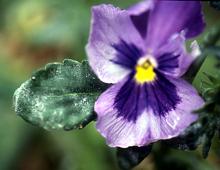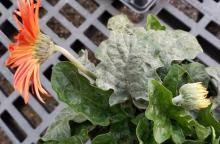Cause Many different named fungi but all are related with a similar life history and applicable management tactics. The following have been found in the PNW including but not limited to Erysiphe aquilegiae (formerly Erysiphe polygoni), Golovinomyces cichoracearum (formerly Erysiphe cichoracearum), Golovinomyces orontii (formerly Erysiphe cichoracearum), Podosphaera delphinii (formerly Sphaerotheca humuli var. fuliginea), Podosphaera fusca (formerly Sphaerotheca macularis), and Podosphaera violae (formerly Sphaerotheca macularis). These are highly specialized pathogens that form a close association with the host. Conditions that favor the host also tend to favor the pathogen. The disease is favored by low light, warm conditions (60 °F to 80°F) and cool nights. Overcrowding of plants is also favorable for disease development. Repeated outbreaks affect plant vigor and production.
These fungi may survive in sexual fruiting bodies (chasmothecia) associated with plant debris and/or as mycelia within infected buds. Sources may be inside or outside the greenhouse including, among other sources, the introduction of new (diseased) plants. Conidia that develop within colonies are released in response to abrupt decreases in relative humidity. Air currents blow conidia to healthy foliage where they start new colonies. Spores can germinate within 6 hours at 68°F and establish an infection within 24 hours. However, temperatures above 85°F inhibit the process. Too much water, such as flowing water or rain, destroys spores by causing them to burst. The fungus does not grow in a leaf or flower but rather across the surface. Small anchor cells of the fungus, haustoria, do grow into the leaf and take nourishment from the plant, but the main filament and the multitudes of spores it produces are outside the leaf. Temperatures of 70°F are optimal for colony development; however, temperatures >85°F are inhibitory to hyphal growth, sporulation and haustorial formation. The disease can develop under relatively dry conditions in spring and summer so long as the air is humid. Multiple disease cycles can occur during a single growing season.
Symptoms Symptoms may vary widely. Early development can be subtle on the leaf surface and best seen on the leaf underside. Upper leaf surfaces may show only slight chlorosis in diffuse spots. Turning the leaf over can reveal a sparse to heavy mycelial growth that can be white to gray. Early symptoms can be easier to find when the sun is over the back of your shoulder highlighting the colony. In other cases, a dense white powdery coating may form on leaves, stems, and/or flowers. All aboveground plant parts can become infected including the flower stalk and petals. New infections are typically bright white then become gray with age. In severe infections, reddish margins of dead tissue may surround the spots. Leaves may be somewhat deformed if they are infected before they have fully developed. Infected plant parts may be dwarfed and stunted. Some premature defoliation may also be observed. Plant vigor and stem quality can be reduced. The disease may be confused with spray residues, especially if using electrostatic sprayers.
Cultural control
- Start with healthy stock plants.
- In some cases there may be resistant cultivars, which will be very useful if you have a history of powdery mildew.
- Good air circulation will help ensure uniform environmental growing conditions for the crop including both 'uniform' temperature and lighting. Space plants so they are not overcrowded and circulate the air in the greenhouse using fans.
- Keep relative humidity low.
- Scout plants weekly. On one out of 30 plants, inspect four fully expanded leaves in the middle of the plant. If powdery mildew is found, scout one out of 10 plants.
- Remove and destroy infected plant parts. (Seal in plastic before disposal so infected tissue does not move throughout the greenhouse.) General greenhouse sanitation will help with overall disease management.
- It is thought that high greenhouse temperatures (greater than 85°F) may be used to help control an outbreak if powdery mildew occurs early in the production cycle. This also will be dependent on the tolerance of your crop to such temperatures.
- Eliminate any volunteer plants that may be growing under benches, between greenhouses, or on cull piles.
- Brief exposure to red light with red light-emitting diodes during the dark period reduced the severity of powdery mildew on greenhouse grown roses. Exposure to ultraviolet light during the night had a similar effect. These tactics may be useful in some cases in the PNW.
Chemical control Monitor crop carefully, and use sprays at first sign of the disease. Fungicides will do best when used before symptoms develop. Good coverage is essential. Few materials have good eradicant activity. Use at 7- to 14-day intervals; using shorter intervals when conditions favor disease development. See labels for reentry intervals and crop safety.
Fungal strains can become resistant to a fungicide when it is used exclusively in a spray schedule. To reduce the possibility of resistance, alternate or tank-mix fungicides that have different modes of action. Limit the use of any one group during the growing season.
Note Water alone has been shown in many powdery mildew systems to reduce disease severity compared to doing nothing at all. In some systems, such as rose powdery mildew, frequent applications (every 3 to 7 days) are good enough for commercially acceptable control. The addition of an adjuvant, that breaks the surface tension of water, can significantly improve control. Many materials (chemical or biological) of questionable activity may suggest the addition of such adjuvants (such as mineral oil) and thus may not be worth the additional cost themselves.
- Bicarbonate-based products such as Kaligreen and MilStop (85% potassium bicarbonate) have been used and might supplement a normal program when powdery mildew is first observed. Do not mix with acidifying agents. Thorough coverage is essential. O
- Botanical extracts might supplement a normal program. See also horticultural oils below. Oregon only. O
- Group 1 fungicides, which include thiophanate-methyl-based products such as Cleary's 3336 and OHP 6672, were active on powdery mildews. Heavy use long ago encouraged the development of resistant strains that may still be around today even if you have never used these materials. Thus, always use along with another fungicide.
- Group 3 fungicides such as Eagle 20 EW, and Terraguard SC are very active on powdery mildew as well as several other diseases. Although these materials are translaminar or systemic (move into the green plant tissues) they only move up in the transpiration stream and thus good coverage is still needed. Total release fungicides may not provide adequate coverage of the underside of leaves. Heavy use has developed many resistant strains so limit the total number of applications to any single crop. At high rates with some materials on some crops there may be a growth regulation effect that can result in shortened internodes and smaller deeper green leaves.
- Note Plant growth regulators have been used to enhance disease management when combined with fungicides in several host-pathogen systems. Type II PGRs, however, will encourage resistance development to Group 3 fungicides.
- The Group 5 fungicide Pipron is registered for use against powdery mildew. Better control if used under slow-drying conditions. Although these materials are translaminar or systemic (move into the green plant tissues) they only move up in the transpiration stream and thus good coverage is still needed. Resistance risk is high so limit the total number of applications to any single crop.
- Group 7 fungicides, the carboxamides, are available alone and in pre-packaged mixes. The newer materials in this group have been very effective on powdery mildew. Resistance is a problem, which is why they are not to be used alone.
- Group 11 fungicides such as Compass, Disarm, Fame, Heritage, and Insignia are very active on powdery mildew as well as several other diseases. Although these materials are translaminar or systemic (move into the green plant tissues) they only move up in the transpiration stream and thus good coverage is still needed. Uptake of this group into plant tissues is slightly slower than with Group 3 fungicides. Resistance risk of these materials on powdery mildew is high so limit the total number of applications to any single crop. Read labels carefully as some do not allow the addition of organosilicate additives.
- Seido at 4 to 5 fl oz/100 gal water plus an adjuvant. Group 50 fungicide. 4-hr reentry.
- Horticultural Mineral Oils, which include many petroleum or botanically based oils, are generally effective from 1% to 2% volume to volume. Products may include JMS Stylet Oil, Neem Oil, Rango, or SuffOil-X. In general the petroleum-based oils are more effective than the botanically-based oils. Necrotic foliage may result if applied within 10 days of any sulfur application. Do not use above 90°F or when plants are under heat or moisture stress. Do not use when foliage is wet because good coverage is essential. O
- Phyton 27 is registered as a copper-based (Group M1 fungicide) material and might be useful to supplement a normal program.
- Regime (BLAD) at 20.5 to 45.7 fl oz/A. Product needs 2 to 4 hours drying time. Group BM01 fungicide. 4-hr reentry.
- Soaps such as M-Pede can be used to supplement a normal program. Do not use within 24 hr of a sublimated sulfur application or within 5 days of other sulfur applications. Do not apply more than three (3) times successively. Check label, many plants, such as Japanese maple, bleeding heart or sweetpeas, are too sensitive to be sprayed. O
- Sulfur, Group M2 fungicide, is both cheap and effective but plants may be very sensitive especially above 85°F. Do not use within 30 days of an oil spray. May stunt shoots of some plants. Frequent handling can irritate worker's skin. The use of sulfur burners (sublimation) was very popular and effective but of unknown availability and legality. O
- Several combination products of the above groups are also registered including Broadform (Group 7+11), Mural (Group 7 + 11), Orkestra (Group 7 + 11), and Pageant (Group 7 + 11).
Biological control
- Aviv (Bacillus subtilis strain IAB/BS03) at 10 to 30 fl oz/100 gal water. Unknown efficacy. 4-hr reentry. O
- Cease or Rhapsody (Bacillus subtilis strain QST 713) at 2 to 8 quarts/100 gal water. Active ingredient is a small protein. Efficacy in the Pacific Northwest is unknown. 4-hr reentry. O
- Subtilex NG (Bacillus subtilis stain MBI 600) at 0.4 to 1.2 oz/1,000 sq ft is registered. Unknown efficacy in the PNW. Group BM02 fungicide. 4-hr reentry. O
Reference Dik, A.J., Carver, T.L., Bushnell, W.R., and Belanger, R.R. 2002. The powdery mildews: a comprehensive treatise. American Phytopathological Society.
Guarnaccia, V., Hand, F. P., Garibaldi, A. and Gullino, M. L. 2021. Bedding plant production and the challenge of fungal diseases. Plant Disease, 105:1241-1258.



